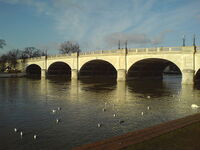| BRIDGE | ||
| Kingston Bridge | ||
|---|---|---|

| ||
| Carries | A308 road | |
| Maintained by | ||
| Design | Arch Bridge | |
| Total Length | 382 feet 0 inches (116.4 m) | |
| Clearance Below | - | |
| Opening Date | 1729 | |
Kingston Bridge is a road bridge at Kingston upon Thames in London, England, carrying the A308 across the River Thames. It joins the town centre of Kingston in the Royal Borough of Kingston upon Thames, to Hampton Court Park, Bushy Park, and the village of Hampton Wick in the London Borough of Richmond upon Thames. As of 2005, it carries approximately 50,000 vehicles per day with up to 2,000 vehicles per hour in each direction during peak times.
Kingston Bridge is on the reach above Teddington Lock and close to and downstream of the mouth of the Hogsmill River, a minor tributary of the Thames. It is on the route of the Thames Path.
History[]
Kingston Bridge was the only crossing of the river between London Bridge and Staines Bridge until Putney Bridge was opened in 1729. This contributed greatly to Kingston's success as a medieval market town. According to John Leland, writing in under the Tudors there was a bridge in Saxon times. He wrote "And yn the old tyme the commune saying ys that the bridge where the commun passage was over the Tamise was lower on the ryver then it is now. And when men began the new town in the Saxons tymes they toke from the very clive of Comeparke (cliff of Coombe Park) side to build on the Tamise side; and sette a new bridge hard by the same." Leland refers to a contemporary bridge and there is evidence that a wooden bridge had existed at Kingston since the 13th century. This was downstream of the present bridge where Old Bridge Street at Hampton Wick was matched by an Old Bridge Street on the Kingston side - the former Saxon bridge being further downstream.
As a crucial link between Surrey and Middlesex, the mediaeval timber bridge was susceptible to destruction during civil conflict as happened during the Wars of the Roses and Wyatt's rebellion. There are records of tolls being granted for a number of years to pay for repairs to the bridge, but in 1567, Robert Hamond made it a free bridge for ever. However in spite of his endowments it appears by the 18th century some tolls had been reimposed. The bridge was described in 1710 "The great Wooden Bridge hath 20 interstices: two in the middle wide enough for barges...it had 22 pierres pf Wood and had in the middle two fair Seates for Passengers to avoid Carts and to sit and enjoy the delightfull Prospect".

A view of Kingston Bridge published in 1831. It has been widened twice since then.
In 1825 Kingston Corporation notified the City of London Corporation Navigation Committee that it intended to build a new bridge. This masonry bridge was completed in 1828. It was built of Portland stone, and consisted of five elliptical arches, the centre arch being a 60 feet span by 19 in height, and the side arches 56 and 52 feet spans respectively. The abutments were terminated by towers or bastions, and the whole surmounted by a cornice and alustrade, with galleries projecting over the pier; which gave a bold relief to the general elevation. The length of the bridge was 382 feet by 27 feet in width. It was of chaste Grecian architecture, from the design of Mr. Lapidge. The building contract was undertaken by Mr. Herbert for £26,800. and the extra work has not exceeded £100, a very rare, if not an unprecedented occurrence in either public or private undertakings of this description. The first stone was laid by the Earl of Liverpool, November 7, 1825, and the bridge was opened in due form by her royal highness the Duchess of Clarence, on July 17, 1828.
Th bridge became free from tolls in 1870, and celebrations including a fireworks show were followed a few days later with the burning of the toll-gates on Hampton Green. It was widened between 1912 and 1914 with the carriageway increased from 25 feet to 55 feet. A new facade of Portland stone was designed to replicate the features of the original. The bridge was widened again in 2000 to also include two bicycle lanes, larger pavements and a bus lane.
The Twickenham Museum page is [1], the Engineering Timeline page is [2] and some images here.
| This page uses Creative Commons Licensed content from Wikipedia (view authors). That Wikipedia page probably contains more information. |